|
 |
| |
NEWSLETTER - January 6, 2011 - "How to Eat Healthier and Be Wealthier" |
| |
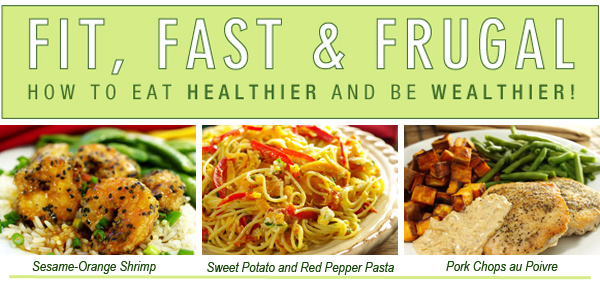
Happy New Year! Most New Year's resolutions, we're told, involve renewed determination for being healthier and wealthier. These two goals mesh wonderfully in the cooking world where a couple modest shifts in the kitchen can have a positive, cumulative return.
IN THIS ISSUE, we suggest our list of top ten alterations that will support you in your shift toward health and wealth. We investigate the possibilities of the humble skillet as a key tool for creating healthy meals fast, and conclude with three recipes from the EatingWellTM kitchens that will help you achieve your goals for fitness and frugality while maximizing flavor - all accomplished quickly!
|
|
|
|
|
|
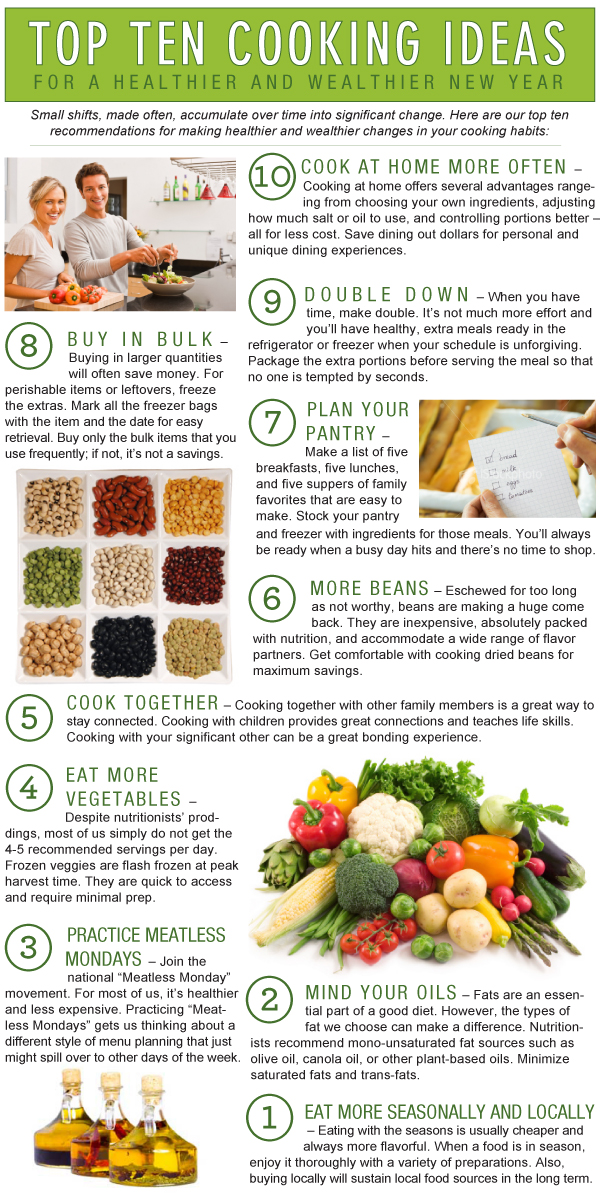 | |
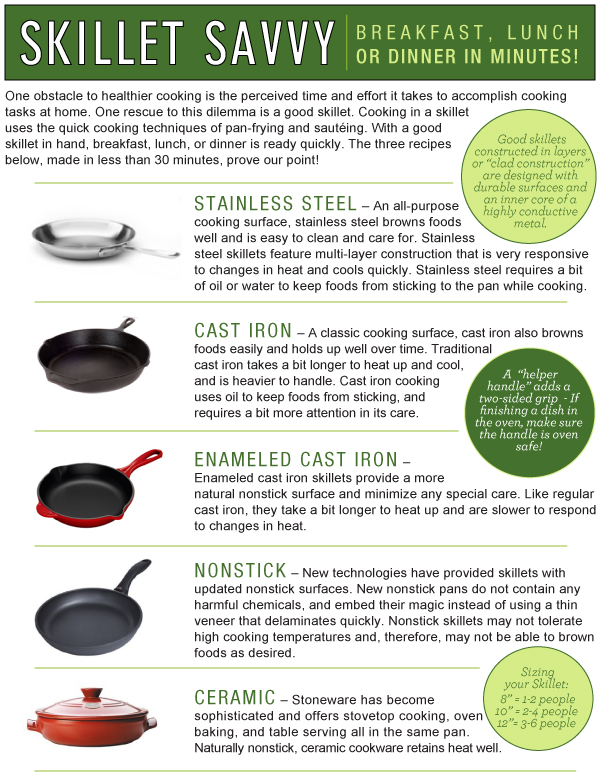 | |

Tip #1: To keep your stainless steel cookware looking good, clean well after each use in warm soapy water. Most stainless steel may also be placed in the dishwasher. Any water spots may be removed with a micro-fiber cloth, or with the slightest bit of vinegar on a cloth. Always avoid scouring pans; instead use an approved stainless steel cleaner.
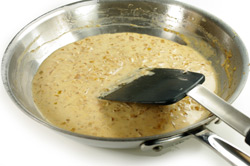 Tip #2: Allow pans to cool for a few minutes before immersing in dishwater. The change in temperature may shock the metal causing the pan to warp irreversibly. Tip #2: Allow pans to cool for a few minutes before immersing in dishwater. The change in temperature may shock the metal causing the pan to warp irreversibly.
Tip #3: When choosing a stove burner for cooking with your skillet, choose the burner that best matches the size of your skillet, or a burner that is slightly smaller than the bottom surface. Flames or heat up the sides of a skillet is wasted energy.
Tip #4: A skillet is perfect for making finishing sauces that call for reducing a liquid. Reducing liquid concentrates flavors by removing water in the form of steam. A skillet's broad bottom provides maximum surface area for the steam to escape. Reduced sauces often impart delicious magic to the final dish.
Tip #5: Overcrowding a skillet will challenge the pan's ability to retain or recover its heat, and will tend to steam the foods instead of pan-frying or sautéing. |

Q: How do I know when the skillet is hot enough for cooking?
A: There are many ways to assess the temperature of a heating skillet: (1) Hover your hand above the skillet to get a sense of its gathering heat. (2) In a dry, heated skillet, pour in a few drops of water. If the water forms a ball that dances across the pan, it is an ideal temperature; if the water shatters into many pieces, it is too hot. (3) In an oiled and heated skillet, the oil's surface will shimmer and move when hot. A flick of water off the tip of your finger should sizzle, though take care to avoid any oil splatters. If the oil begins to smoke, the pan is too hot.
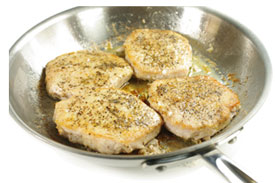 Q: What is fond? Q: What is fond?
A: Fond is the brown portion of food that forms particularly when cooking meats. When proteins and sugars are exposed to heat together, they undergo a caramelization process known chemically as a Maillard reaction. The "brown bits," (as they are sometimes called), at the bottom of the pan have formed complex flavors and create the foundation for many delicious sauces. When frying or sautéing is done, deglaze the pan and gather up all of the fond by adding liquid, stock, or wine, to the pan, then proceed in finishing the sauce with seasonings and other ingredients.
Q: What is the difference between pan-frying and sautéing?
A: Pan-frying uses a medium to medium-high heat and enough oil to keep foods from sticking. With pan-frying, foods are allowed to cook without a lot of stirring or moving about, just flipping to finish the other side. In contrast, sautéing uses more heat, less oil, and more stirring and turning of the food so that all of it cooks evenly. Pan-frying is suitable for larger pieces of food, while sautéing requires smaller, similarly sized pieces.
Q: What's the difference between a skillet and a sauté pan?
A: Both pans are similar in many ways. The bottom surface of each style of pan is the cooking surface; the sides are less critical to the cooking process. A skillet generally has sloped sides and a sauté pan has straight sides. The sloped sides of a skillet make it easier to use a turner, while the straight-sides of a sauté pan are more effective in keeping ingredients in the pan when stirring and tossing the food. |

|
EatingWellTM on a Budget by Jessie Price and the EatingWellTM Test Kitchen. Published by The Countryman Press, Woodstock, VT. Copyright 2010.
| 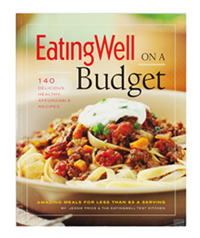 |

The EatingWellTM folks have done it again! They've created a great collection of recipes that shift us to a healthier lifestyle full of flavor, all without a hint of asceticism or curtailed eating pleasure. A pleasant mix of new recipes and favorites with a healthy makeover, this book is great companion for pursuing "healthy and wealthy" in the New Year. And, in addition to the healthy character of each of the recipes, they have crafted the book to contain foods that are less than $3 per serving. A hallmark of EatingWellTM publications is their practical aspect; the recipes are for real people, with busy lives, who like good food but may not always have the time or budget for daily gourmet cooking. The book covers breakfast, lunch, dinner, and snacks. There are a generous number of tips for being budget conscious while eating healthily. The recipes are clearly written, identify total and active time requirements, and detail nutritional components of each dish. We love how EatingWellTM has put all our New Year's resolutions together in one systematic guidebook. |
|


|
Sesame-Orange Shrimp
View and Print
In 30 minutes, shrimp are lightly coated in a simple cornstarch mixture and quickly pan-fried in a skillet. A delicious, super-easy sauce of orange juice and soy sauce completes the dish. Made in less than 30 minutes, the shrimp were served over rice and accompanied by pea pods. It's a healthy, low-calorie supper meal that is satisfyingly delicious.
| 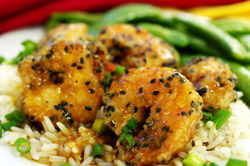 | |
Sweet Potato and Red Pepper Pasta
View and Print
In less than 30 minutes, a great pasta dish is on the table. Shredded sweet potatoes along with red bell pepper strips provide a healthy dose of Vitamins A and C in a colorful presentation. An easy "sauce" is formed with the addition of goat cheese. The equal parts of veggies and pasta keep the calories per serving lower than typical pasta dishes. The leftovers were just as tasty!
| 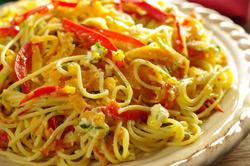 | |
Pork Chops au Poivre
View and Print
In 20 minutes, these pork chops are ready. Pork tends to be an inexpensive cut of meat, yet quite tender and lean. This recipe plays on the classic Steak au Poivre, only now as a pork variation. The recipe makes excellent use of a good skillet and demonstrates the process of deglazing a pan and the making of a delicious finishing sauce.
| 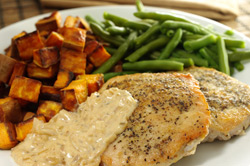 | |
Recipes from EatingWell on a Budget by Jessie Price and the EatingWellTM Test Kitchen through permission of The Countryman Press, Woodstock, VT. Copyright 2010. All rights reserved.
|
|
|
We want to thank all our customers for a wonderful holiday season. It was a joy serving you, and we wish you a peaceful, healthful, and bountiful New Year!
From all of the Staff at Spoon & Whisk
|
|
| Copyright 2011 - Acorn Advisors | Spoon & Whisk | 518.371.4450 | 1675 Route 9 | Clifton Park | NY | 12065 |
|
|
|
|



